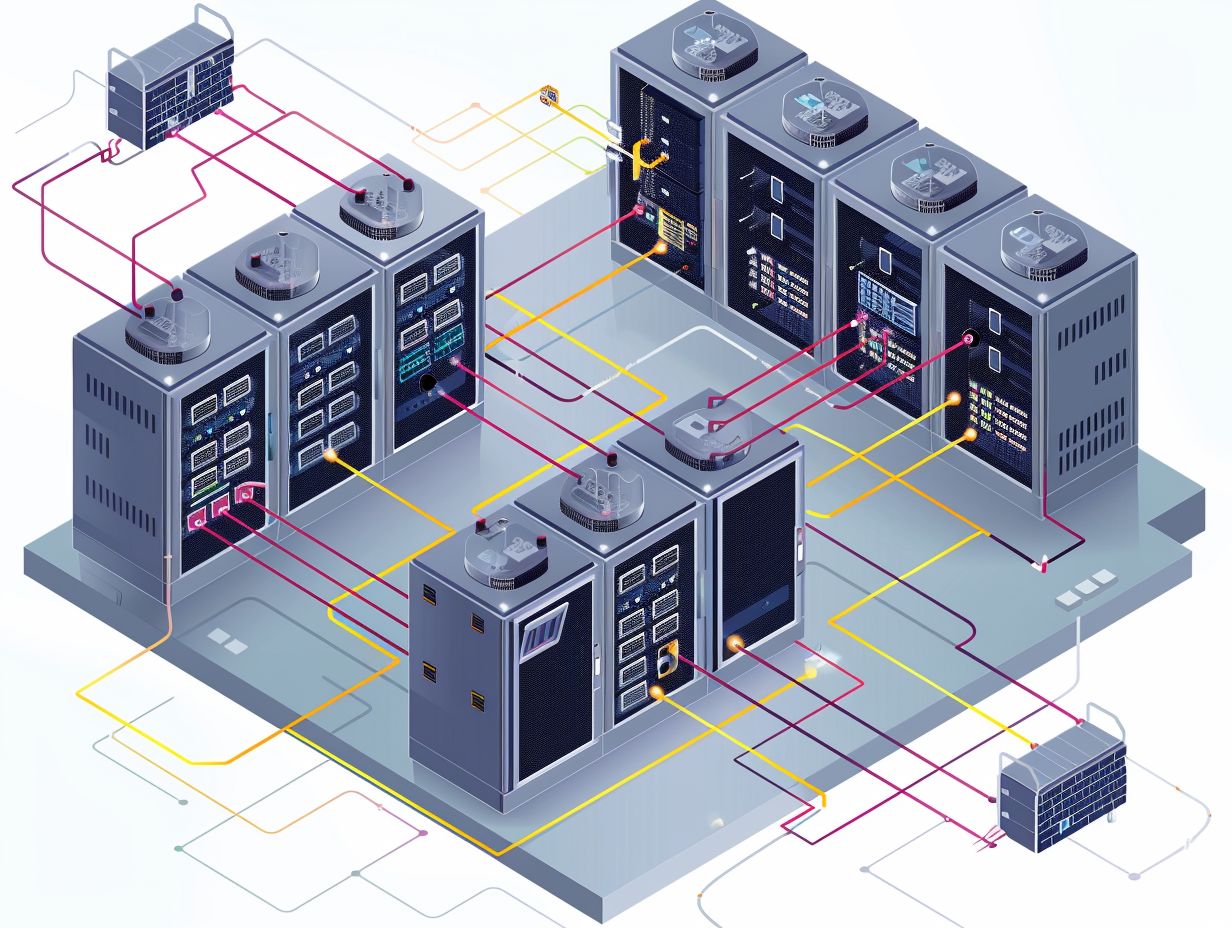Are you interested in learning about what a SAN is and how it operates in a Cisco data center environment? The key components of a Cisco Data Center SAN, encompassing hardware and software elements, will be examined.
Configuration and management of a Cisco SAN will be discussed, with a focus on the steps required for establishing and upholding this critical infrastructure. Discover Cisco Data Center Network Virtualization fundamentals, which include enhanced performance, scalability, cost efficiencies, and streamlined management.
Additionally, common obstacles and resolutions in Cisco SAN deployment will be addressed, alongside an exploration of the technology’s future through emerging trends and technologies.
Key Takeaways:

What is a SAN and How Does it Work?
A Storage Area Network (SAN) is a high-speed network that connects storage devices with servers and provides block-level data storage access. SANs utilize protocols such as Fibre Channel and iSCSI to transfer data between storage devices and servers, enabling centralized data storage for various applications.
By establishing a dedicated network solely for storage purposes, SANs segregate storage traffic from regular network traffic, reducing congestion and enhancing the overall performance of network applications. The block-level storage access provided by SANs allows for efficient data retrieval and storage, making it easier for multiple servers to access shared storage resources simultaneously. SAN technology also enhances data security through zoning and masking techniques, ensuring that only authorized servers can access specific storage resources within the network.
Components of Cisco Data Center SAN
The components of your Cisco Data Center SAN encompass advanced SAN technology, which is supported by Fibre Channel and iSCSI protocols, integrated SAN solutions, Cisco MDS switches tailored for SAN fabric connectivity, SAN infrastructure dedicated to data storage, and Network-Attached Storage (NAS) for file-level data access.
Within this configuration, Fibre Channel assumes a critical role in providing high-speed, low-latency connectivity for storage networks. This functionality ensures swift and dependable data transfers between servers and storage devices.
Similarly, iSCSI enables storage communication across IP networks, offering a cost-effective alternative to Fibre Channel. The SAN fabric, comprising interconnected switches and storage arrays, serves as the backbone of the SAN environment, facilitating seamless communication and efficient data access.
The SAN infrastructure incorporates storage arrays, disk storage, and backup solutions to ensure secure and scalable data storage. Additionally, NAS delivers centralized file storage, enabling effortless access and data sharing throughout the network.
Hardware and Software Components
In a Cisco Data Center SAN, the hardware components in the system include switches, storage arrays, and network adapters, while the software components consist of SAN management software and operating system integration. Key elements for efficient SAN operation encompass hardware-based analytics, congestion control mechanisms like Dynamic Incast Response Logic (DIRL), high-speed 64G Fibre Channel (FC), and solution features, all of which necessitate collaboration between IT teams for seamless management.
Hardware-based analytics play a critical role in monitoring SAN performance by offering real-time insights into traffic patterns, potential bottlenecks, and overall system health. Congestion control mechanisms, such as DIRL, aid in the prevention of network congestion and the maintenance of consistent data flow. High-speed 64G Fibre Channel (FC) technology facilitates rapid data transfer rates between servers and storage devices, thereby boosting system efficiency. These advanced features ensure the smooth and efficient operation of the Cisco Data Center SAN, underscoring the importance of skilled IT teams in supervising and managing the intricate SAN operations.
Cisco SAN Configuration and Management
When configuring a Cisco SAN, you should focus on designing an efficient SAN architecture that aligns with your organization’s needs. This involves integrating SAN technology and infrastructure components, establishing protocol configurations for data transfer, and implementing robust management practices to monitor and optimize SAN performance.
Crucial factors to consider during Cisco SAN configuration include storage requirements, scalability, and performance to ensure optimal functionality. Best practices for SAN design recommend utilizing redundancy in hardware components like switches and storage arrays to minimize single points of failure.
Implementing zoning and masking strategies within the SAN fabric can enhance security and control data access. To optimize SAN performance, administrators can utilize tools for monitoring and analyzing SAN traffic, identifying bottlenecks, and making necessary adjustments to enhance efficiency.
Steps for Setting Up and Managing a SAN
Setting up and managing a Storage Area Network (SAN) involves conducting a comprehensive assessment of your organization’s storage requirements, selecting appropriate SAN topologies to meet performance needs, implementing SAN solutions to modernize data connectivity, and realizing the benefits of enhanced data management and scalability.
Once your storage requirements have been evaluated, the next crucial step is to align the chosen SAN topology with the specific needs and goals of your organization. By ensuring that the selected SAN configuration matches the data throughput, availability, and recovery objectives, you can optimize your storage infrastructure for maximum efficiency.
Modernizing connectivity within the SAN environment can lead to improved data transfer speeds, reduced latency, and enhanced overall performance. This evolution towards advanced connectivity options boosts productivity and supports seamless integration with emerging technologies.
Benefits of Cisco Data Center SAN

Utilizing Cisco Data Center SAN offers significant benefits to businesses and organizations in terms of:
- Improved performance and scalability
- Enhanced data availability and reliability
- Streamlined data management
- Optimized resource utilization
Implementing Cisco Data Center SAN not only enhances operational efficiency but also future-proofs business infrastructure. The high-speed connectivity provided by SAN accelerates data transfer, enabling real-time decision-making. Its seamless integration with existing systems ensures a smooth transition and minimizes downtime. These advantages contribute to a more agile and adaptable IT environment, allowing businesses to effortlessly scale up alongside increasing data requirements. By ensuring data availability and reliability, Cisco Data Center SAN plays a crucial role in safeguarding critical information, promoting a secure and resilient business ecosystem.
Improved Performance and Scalability
One of the key benefits of Cisco Data Center SAN is the improved performance and scalability it offers to data centers by enhancing information access, optimizing data storage efficiency, and enabling network-based storage solutions that facilitate seamless data sharing and collaboration.
This robust system ensures that vital data can be accessed quickly and efficiently across various applications and platforms, ultimately boosting productivity and operational efficiency. By leveraging network-based storage solutions, Cisco Data Center SAN enables organizations to achieve high availability and fault tolerance for critical data, ensuring business continuity and data integrity. The seamless integration of storage resources within the network infrastructure enhances the overall performance of the data center, contributing to a more agile and responsive IT environment.
Cost Savings and Simplified Management
When you implement Cisco Data Center SAN, significant cost savings can be achieved for your business or organization. This is accomplished by streamlining data management processes, reducing infrastructure complexity, enhancing application performance, and leveraging advanced SAN technology to improve operational efficiencies.
The improved efficiency directly contributes to better operational outcomes and financial savings for your organization. By simplifying data storage and network management through Cisco Data Center SAN, you can reduce your total cost of ownership, optimize resource allocation, and attain a higher return on investment.
The streamlined operations in the data center lead to more efficient use of infrastructure resources, ensuring that applications run smoothly and effectively. With Cisco’s cost-effective solutions, businesses can also benefit from enhanced security and compliance measures, ultimately boosting overall organizational effectiveness.
Common Challenges and Solutions in Cisco SAN Deployment
Despite its benefits, your Cisco SAN deployment may encounter common challenges like network congestion, data accessibility issues, and performance bottlenecks. These challenges require proactive troubleshooting, effective data center management, and timely solutions to ensure uninterrupted operation of your SAN.
To troubleshoot network congestion in your Cisco SAN deployment, it is crucial to monitor traffic patterns, identify bottlenecks, and optimize the network configuration. Implementing Quality of Service (QoS) policies can assist in prioritizing critical data traffic and preventing congestion.
When addressing performance issues, conducting regular performance monitoring, optimizing storage allocation, and updating firmware and software can improve SAN efficiency. Effective data center management is pivotal in SAN deployment, ensuring proper resource allocation, security measures, and disaster recovery strategies to protect critical data and maintain seamless operations.
Addressing Common Issues and Troubleshooting
When addressing common issues and troubleshooting in a Cisco SAN, you need to focus on identifying the root causes of problems, ensuring data center availability and reliability, implementing effective troubleshooting strategies, and optimizing SAN performance for uninterrupted data access.
One key aspect of troubleshooting in a Cisco SAN involves regularly monitoring system performance metrics such as latency, throughput, and error rates to proactively detect any potential issues. It is crucial to maintain updated firmware and software patches to ensure system security and stability. Conducting regular backups of critical data helps minimize data loss in case of failures. Having clear documentation of the SAN architecture and configurations can significantly streamline the troubleshooting process when issues arise.
A proactive approach combined with a thorough understanding of SAN components is essential for efficient troubleshooting and optimizing data center operations.
Future of Cisco Data Center SAN
The future of Cisco Data Center SAN is being shaped by emerging technologies such as Non-Volatile Memory Express (NVMe), advanced data replication techniques, and RAID technology advancements. These innovations are facilitating improved data accessibility, enhanced business continuity, and future-proof solutions for organizations seeking robust data storage and management capabilities.
NVMe technology is on the verge of revolutionizing the data storage landscape by significantly reducing latency and elevating performance levels. With the growing need for real-time data processing and analysis, NVMe over Fabrics (NVMe-oF) is emerging as a promising solution for high-speed data transfers. Progress in data replication methods is bolstering data protection and disaster recovery strategies, ensuring the establishment of resilient data management frameworks within organizations. As SAN technology progresses, the emphasis is increasingly placed on scalability, flexibility, and cost efficiency, fostering innovation in the data center storage sector.
Emerging Technologies and Trends

The future of Cisco SAN will witness an evolution in SAN infrastructure to support increasingly complex application workloads, integrate cutting-edge technologies for data storage and access, and adapt to dynamic business requirements, reflecting a paradigm shift towards more efficient and scalable SAN solutions.
This evolution is being driven by rapid technological advancements such as NVMe over Fabrics (NVMe-oF) and Storage Class Memory (SCM) which are revolutionizing the way data is stored, retrieved, and processed in SAN environments. Organizations are now focusing on implementing software-defined storage solutions and hyperconverged infrastructure to streamline their SAN operations and improve agility.
The rise of artificial intelligence and machine learning is prompting innovations in predictive analytics and automation, further enhancing the performance and reliability of Cisco SAN systems.
Frequently Asked Questions
What is Cisco Data Center Storage Area Network (SAN) Fundamentals?
Cisco Data Center Storage Area Network (SAN) Fundamentals refers to the basic principles and concepts of storage area networking within a Cisco data center environment. It covers topics such as storage protocols, storage architectures, and best practices for managing data center storage networks.
What are some common storage protocols used in Cisco SANs?
Some common storage protocols used in Cisco SANs include Fibre Channel, Fibre Channel over Ethernet (FCoE), and Internet Small Computer System Interface (iSCSI). These protocols allow for data to be efficiently transferred and managed within a storage network.
How does a Cisco SAN improve data center performance?
A Cisco SAN can improve data center performance by separating storage traffic from regular network traffic, allowing for faster and more efficient data transfers. It also allows for easier scalability and increased flexibility in managing storage resources.
What is the role of storage virtualization in Cisco SANs?
Storage virtualization is an important aspect of Cisco SANs as it allows for the consolidation of multiple storage devices into a single, centralized storage pool. This leads to improved storage utilization and easier management of storage resources.
What are some best practices for managing a Cisco SAN?
Some best practices for managing a Cisco SAN include regularly monitoring and analyzing storage performance, implementing data protection measures such as backups and disaster recovery plans, and staying up to date with firmware and software updates.
How does data security play a role in Cisco SANs?
Data security is crucial in Cisco SANs as it involves the storage and transfer of sensitive data. Cisco SANs incorporate various security measures such as access controls, encryption, and authentication in order to protect data from unauthorized access and ensure its integrity.

